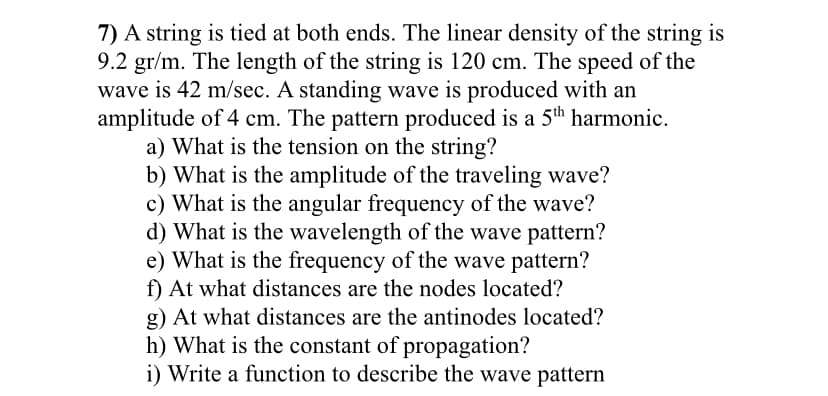7) A string is tied at both ends. The linear density of the string is 9.2 gr/m. The length of the string is 120 cm. The speed of the wave is 42 m/sec. A standing wave is produced with an amplitude of 4 cm. The pattern produced is a 5th harmonic. a) What is the tension on the string? b) What is the amplitude of the traveling wave? c) What is the angular frequency of the wave? d) What is the wavelength of the wave pattern? e) What is the frequency of the wave pattern? f) At what distances are the nodes located? g) At what distances are the antinodes located? h) What is the constant of propagation? i) Write a function to describe the wave pattern
7) A string is tied at both ends. The linear density of the string is 9.2 gr/m. The length of the string is 120 cm. The speed of the wave is 42 m/sec. A standing wave is produced with an amplitude of 4 cm. The pattern produced is a 5th harmonic. a) What is the tension on the string? b) What is the amplitude of the traveling wave? c) What is the angular frequency of the wave? d) What is the wavelength of the wave pattern? e) What is the frequency of the wave pattern? f) At what distances are the nodes located? g) At what distances are the antinodes located? h) What is the constant of propagation? i) Write a function to describe the wave pattern
Physics for Scientists and Engineers, Technology Update (No access codes included)
9th Edition
ISBN:9781305116399
Author:Raymond A. Serway, John W. Jewett
Publisher:Raymond A. Serway, John W. Jewett
Chapter16: Wave Motion
Section: Chapter Questions
Problem 16.11P: The string shown in Figure P16.11 is driven at a frequency of 5.00 Hz. The amplitude of the motion...
Related questions
Question

Transcribed Image Text:7) A string is tied at both ends. The linear density of the string is
9.2 gr/m. The length of the string is 120 cm. The speed of the
wave is 42 m/sec. A standing wave is produced with an
amplitude of 4 cm. The pattern produced is a 5th harmonic.
a) What is the tension on the string?
b) What is the amplitude of the traveling wave?
c) What is the angular frequency of the wave?
d) What is the wavelength of the wave pattern?
e) What is the frequency of the wave pattern?
f) At what distances are the nodes located?
g) At what distances are the antinodes located?
h) What is the constant of propagation?
i) Write a function to describe the wave pattern
Expert Solution
This question has been solved!
Explore an expertly crafted, step-by-step solution for a thorough understanding of key concepts.
This is a popular solution!
Trending now
This is a popular solution!
Step by step
Solved in 5 steps

Knowledge Booster
Learn more about
Need a deep-dive on the concept behind this application? Look no further. Learn more about this topic, physics and related others by exploring similar questions and additional content below.Recommended textbooks for you

Physics for Scientists and Engineers, Technology …
Physics
ISBN:
9781305116399
Author:
Raymond A. Serway, John W. Jewett
Publisher:
Cengage Learning

University Physics Volume 1
Physics
ISBN:
9781938168277
Author:
William Moebs, Samuel J. Ling, Jeff Sanny
Publisher:
OpenStax - Rice University

College Physics
Physics
ISBN:
9781305952300
Author:
Raymond A. Serway, Chris Vuille
Publisher:
Cengage Learning

Physics for Scientists and Engineers, Technology …
Physics
ISBN:
9781305116399
Author:
Raymond A. Serway, John W. Jewett
Publisher:
Cengage Learning

University Physics Volume 1
Physics
ISBN:
9781938168277
Author:
William Moebs, Samuel J. Ling, Jeff Sanny
Publisher:
OpenStax - Rice University

College Physics
Physics
ISBN:
9781305952300
Author:
Raymond A. Serway, Chris Vuille
Publisher:
Cengage Learning

College Physics
Physics
ISBN:
9781285737027
Author:
Raymond A. Serway, Chris Vuille
Publisher:
Cengage Learning

Physics for Scientists and Engineers
Physics
ISBN:
9781337553278
Author:
Raymond A. Serway, John W. Jewett
Publisher:
Cengage Learning

Physics for Scientists and Engineers with Modern …
Physics
ISBN:
9781337553292
Author:
Raymond A. Serway, John W. Jewett
Publisher:
Cengage Learning